
GaWx
-
Posts
17,915 -
Joined
Content Type
Profiles
Blogs
Forums
American Weather
Media Demo
Store
Gallery
Posts posted by GaWx
-
-
-
36 minutes ago, NorthHillsWx said:
Idk, the Brick storm last year lost 13 inches of snow that went to New Orleans after the thread was created
It was great luck for the Gulf coast, S GA, and the E Carolinas! I owe getting my record sleetstorm to Sir Brick.
-
 1
1
-
-
4 minutes ago, SnowDawg said:
OP was a tick towards the Euro at H5 but the GEFS continued to move NW. Will have to dive into the members more to see whether or not that’s just being skewed by some amplified outliers.
It doesn’t look to me like it was due to a skew from amped members. This was a typical notable shift NW in the avg track.
-
 2
2
-
-
-
7 minutes ago, NorthHillsWx said:
I think we can wait until tomorrow to start a storm thread. Until last night there really wasn’t much consensus on there even being a storm would like it to remain on models for a full day before jumping into a thread personally. There isn’t really anything else going on besides in the mountain forum so nothing would be confused with this discussion at this time
Thanks for your thoughts on this. For comparison, @eyewall started the 1/10-11/25 thread 4 days out and @Brick Tamlandstarted the 1/21-2/25 thread 3 days out. So, starting it tomorrow would match Brick’s timing for 1/21-2.
-
-
The 12Z Euro was good for the E Carolinas and extra good from part of SE GA into the E FL panhandle. Of course I’d love for it to verify similarly in this area, but I’m still leaning to the 1/28-9/14 type of NW model trend like the 12Z GFS did due to similar indices to take most or all of it away. We’ll see as every case is somewhat unique:
-
57 minutes ago, donsutherland1 said:
If this were to verify with hardly any -PNA upcoming, that would increase the chance vs earlier runs that Jan will end up net +PNA just like all -ENSO Decs since 1983-4 have transitioned to in Jan.
-
 3
3
-
-
17 minutes ago, SnowDawg said:
Last night I was thinking the setup reminded me of January 28 2014. I’d happily take that. If it wants to go ahead and repeat February of 2014 as well I might just cry tears of joy lol
I remember 1/28/14 originally per models out ~5 days looking to nail coastal areas like mine with a wintry mess and then doing the typical trending NW and reducing coastal area wintry precip. to a lot lower than models had had to a minor event here.
Comparisons of indices for 1/28-9/2014 to progged 1/18/26:
Index…2014….2026
MJO…...6……….….6
PNA….weak +….mod/strong +
EPO….strong -….very strong -
WPO…neutral……….-
NAO….weak +…neutral to weak +
AO…..strong -…..mod -
So, for those of you who want the NW trend to continue and end up similarly to 2014 (not me obviously), the indices line up pretty similarly to 1/28-9/2014 unfortunately for us deep SE folks and fortunately for ATL-RDU and further NW. The main differences though this time are a stronger +PNA and -EPO (i.e., more impressive W NA ridge) and a -WPO vs neutral then. I don’t know whether or not that would change things much vs the 2014 trend.
Now I’ll show how much stronger the W ridge/E trough couplet is this time vs 2014:
1/28/14 12Z H5 had 564 Washington/Canadian border and 559 Atlanta: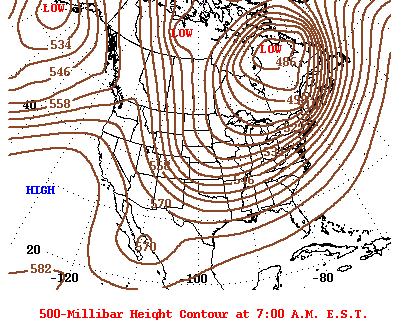
1/18/26 12Z H5 prog 576 Wash/Can border and 546 Atlanta meaning a much more impressive and sharper W ridge/E couplet this time:
-
 2
2
-
-
-
31 minutes ago, wncsnow said:
If I were in Raleigh up to Virginia Beach, I would be getting excited
Actually, with the typical NW trend, which is in reality an unwinding of too far SE biases, you’re very much in this one. I think due to this and backed by climo, you have a better chance than us peeps way down in the Deep South of getting some of this. One never knows since every case is different, which makes forecasting discussions so interesting.
Why is it so quiet in here? It’s not quiet at the other place. I guess most everyone here is sleeping? Or is almost everyone over there?
-
-
The 0Z GFS is giving >1” of snow to this area on Jan 18th, which would be the second straight Jan with measurable snow. That’s never happened since official records started 150 years ago. The closest thing to that would be Jan of 1921’s 0.5” and Jan of 1922’s major icestorm. And then the glorious Jan of 1977 had two.
Climo always says bet against measurable wintry precip here as no more than 25% of winters have had that.
OTOH, there has been increased ensemble support.
But OTOH, there’s the typical NW trend when there’s no -NAO, which would work against it.
So, keeping all of that in mind, I’m taking this with a grain (2m temps are also progged to be marginal as of now with 34-35 being the coldest):
-
 1
1
-
-
16 minutes ago, Daniel Boone said:
Can you research that and see if there's a connection ?
I don’t think I can because I don’t have a list of La Niña by location. If you can provide that, I can break it down.
-
1 minute ago, Daniel Boone said:
Yes. That's what I was referring to irt research. I'd saw a thing or two on where you had did that. Was that dependant on La nina location Larry ?
I didn’t break it down by La Niña location.
-
 1
1
-
-
19 minutes ago, Daniel Boone said:
Just looking at MJO Charts one would expect a mild Pattern in the East. Goes to show other Drivers sometimes dictate or throw the MJO effects off kilter. Even the location of La nina apparently according to some research.
Actually, I did a study recently that surprisingly showed that Jan phase 6 in the SE (using GSP as a representative) has had a mix with a bit more cold vs warm phase 6 Jan periods. Examples of cold during La Niña in Jan:
1975 (8 BN), 1976 (9 BN during a long period of 13 days), 2000 (4 BN), 2011 (7 BN during a long period of 12 days), 2022 (9 BN), and 2025 (5 BN).
There were some mild Jan phase 6 periods during La Niña also like 1989 (+8) and 2008 (+8) although those two were only 3 days long each.Keep in mind though that the current phase 6 started off mild. So, it remains to be seen how cold it will end up overall as it’s progged to last through ~Jan 21st.
-
 2
2
-
 1
1
-
-
From Don Sutherland:
Yes, the PNA is far more important to Atlanta's January snowstorms than the NAO. Since 1950, the PNA was positive for 84.2% of Atlanta's 1" or greater snowstorms. The NAO was negative for 63.2% of such storms.
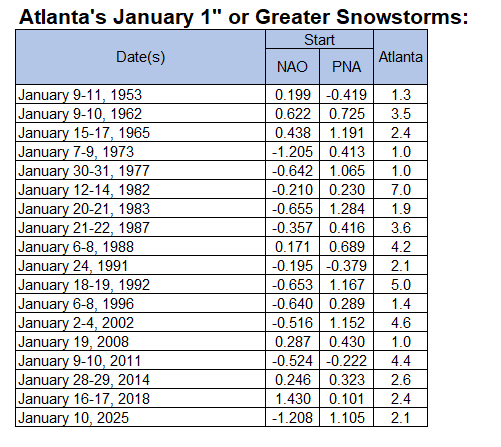
I’ll add that that these Jan snowstorms were during La Niña:
Dates……PNA…….NAO
1/15-17/1965…+1.191…+0.438
1/6-8/1996…+0.289…-0.640
1/19/2008…+0.430…+0.287
1/9-10/2011…-0.223…-0.524
1/16-17/2018…+0.101…+1.430
1/10/2025…+1.105…-1.208
So, just for the six 1”+ Jan storms during La Nina:
-5 of the 6 PNAs were >0 and the lowest was only down to -0.223. Avg PNA was +0.5
-In contrast, 3 of the 6 NAOs were positive with one of them strongly positive. The avg NAO was near 0/neutral.
—————
The 1/18/26 potential SE snowstorm looks like it will be during a moderate MJO phase 6, a strong +PNA, a neutral to moderately -AO, slightly + to neutral NAO, -WPO, and a very strong -EPO, which may be sub -3 then.
So, the highlight is strong +PNA/-EPO during a phase 6.
-
 3
3
-
 1
1
-
-
On 1/12/2026 at 11:32 AM, GaWx said:
How would a potential shift to +AAM late month play into this? Is the +AAM the dog that wags a +PNA and/or phase 8 or do other things wag the AAM? Is the AAM a leader or a follower?
Look how much this changed in just 2 days of runs:
-
 1
1
-
 1
1
-
-
The 12Z EPS for SAV has gotten my attention for the small chance of Sun AM light snow/flurries, which in this area would be a big deal due to the relative rarity being that most winters get nothing, not even a T. We got nothing Feb 2018 through Dec 2024.
My expectations, especially for measurable, are low due to climo, it being pretty dry overall with member qpf progs being light, and marginal temps.
So, fwiw, here are some 12Z EPS images: ~25% of members have snow, which is notably high:Mean: 0.2”, notable for here:
-
 3
3
-
-
31 minutes ago, MJO812 said:
Hope your forecast verifies. Weather is so friggin boring.
Anthony, You just had a snowy December with two significant snowstorms and a colder than normal month. How is that the least bit boring?
-
 1
1
-
-
1 hour ago, donsutherland1 said:
Yes, the PNA is far more important to Atlanta's January snowstorms than the NAO. Since 1950, the PNA was positive for 84.2% of Atlanta's 1" or greater snowstorms. The NAO was negative for 63.2% of such storms.
Don, thanks. From where did you get those stats?
-
The 12Z GEFS and EPS means late in their runs both had a great combo for E US cold of a -AO, -EPO, and -WPO. The NAO is slightly negative on the EPS and ~neutral on the GEFS. The PNA rises to neutral from its prior ~7 days of being negative. Overall, that’s a combo of indices favoring cold in the E US. The MJO is then mainly in 7 and trying to go into 8. If it does, watch out! But if it stalls there and mainly avoids it, the still mainly mild Euro Weeklies for the bulk of Feb would have a better chance of being right.
-
 2
2
-
-
33 minutes ago, 40/70 Benchmark said:
The two emboldened trends are the essence of why winters continue to suck in the east, and will continue to suck, regardless of how cold or warm it is. We need to get rid of this cool ENSO Pacific regime.
How would a potential shift to +AAM late month play into this? Is the +AAM the dog that wags a +PNA and/or phase 8 or do other things wag the AAM? Is the AAM a leader or a follower?
-
 2
2
-
-
Not surprisingly, today’s GEFS mean prog has reduced the max amp of the phase 6-7 from the ~2.7 of two days ago to now being close to the Euro’s ~2.1 today (see below). But it retains the 17 day record breaking long winter phase 6.
Also, note that today’s GEFS turns it left as it approaches phase 8:
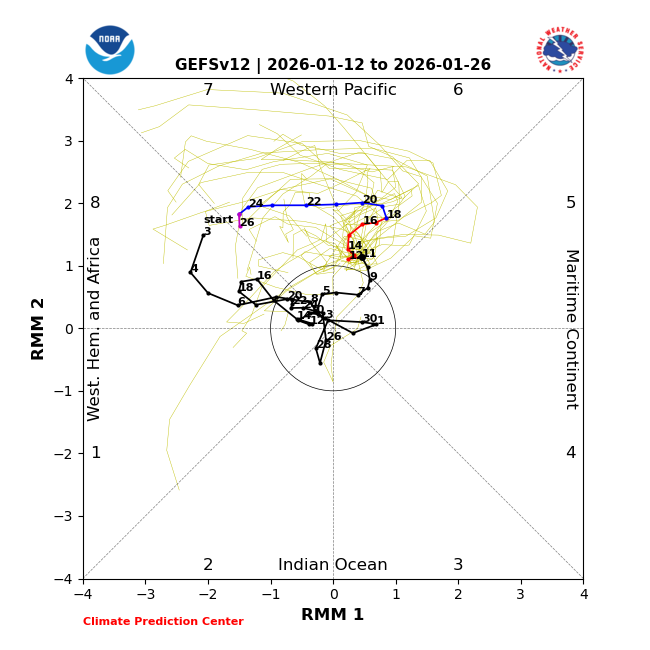
Yesterday’s ext GEFS didn’t turn as much:
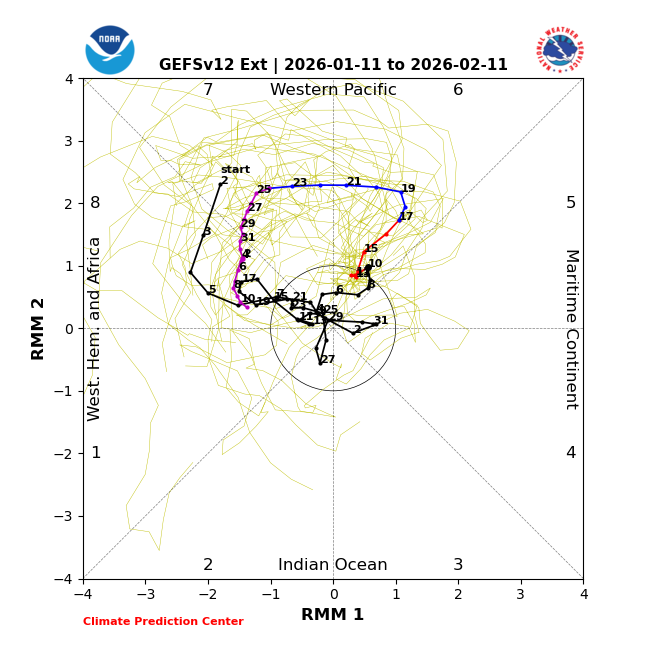
This change should be respected based on the stats for the # of DJF MJO days by phase since 2011 showing that phases 6/7 were the two most frequent phases day by day and that phase 8’s days numbered only ~1/3 of that of phase 7, which is likely due to the strong W Pac warm pool (where phase 7 resides):DJF:
1: 76
2: 96
3: 167
4: 173
5: 212
6: 249
7: 286
8: 95
Whether or not the MJO actually goes into phase 8 late this month and then proceed to 1-2-3 in the first half of Feb will probably play a big role as regards the chance for the +PNA to come right back (if it were to actually go back to a -PNA for ~a week just prior) and the resultant resumption of a cold E US as we look toward the 1st half of Feb. If it ends up not going into phase 8 in a meaningful way, the last 2 Euro Weeklies runs showing a mainly mild Feb would seem to have a better chance to verify. Let’s hope not for those who want it cold.
-
 4
4
-
 1
1
-

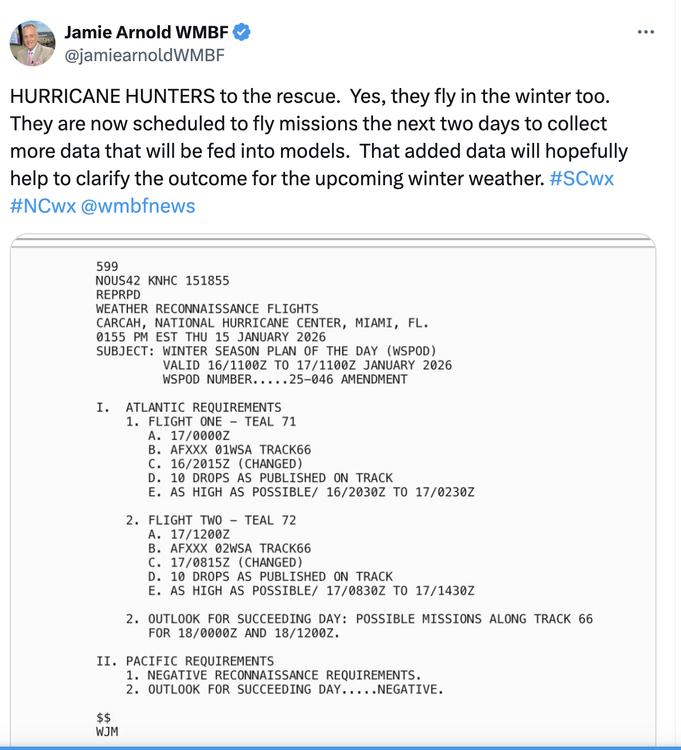
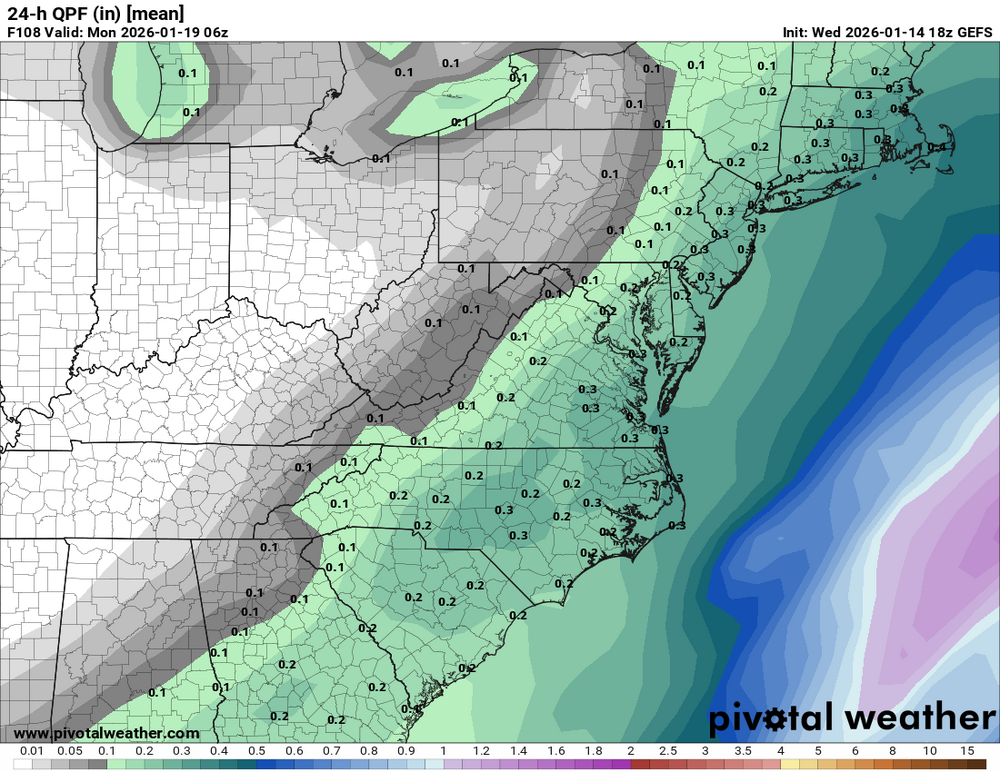
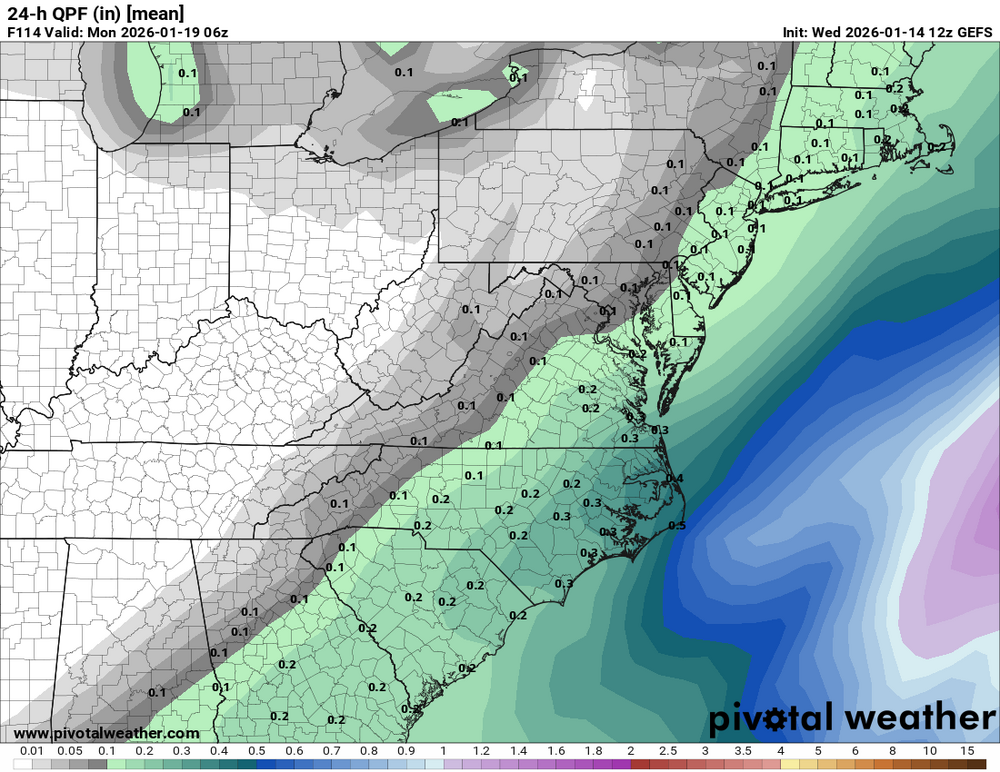
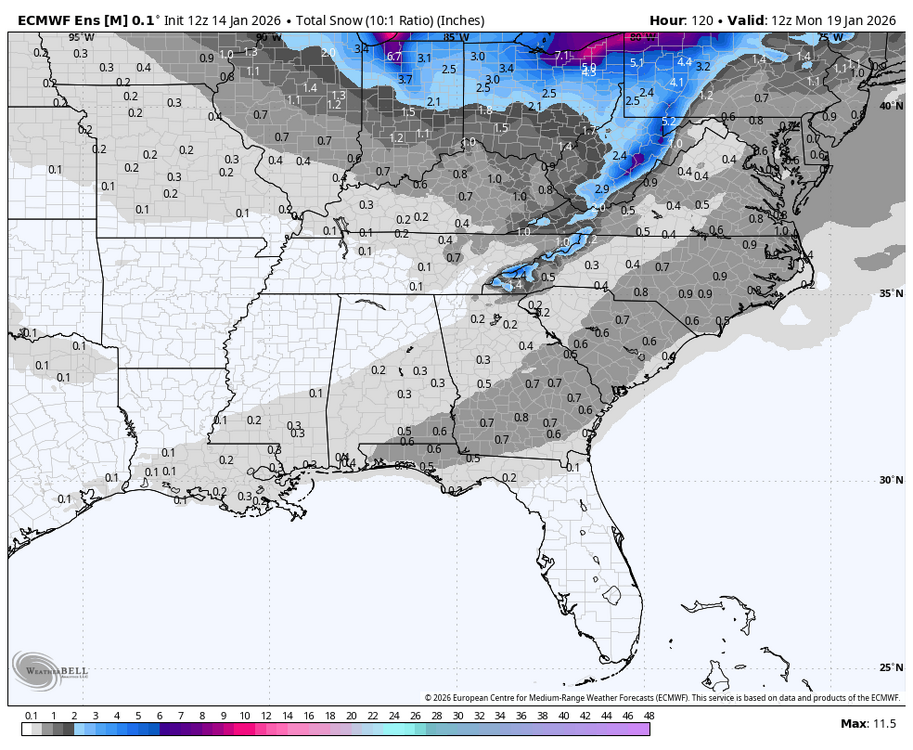
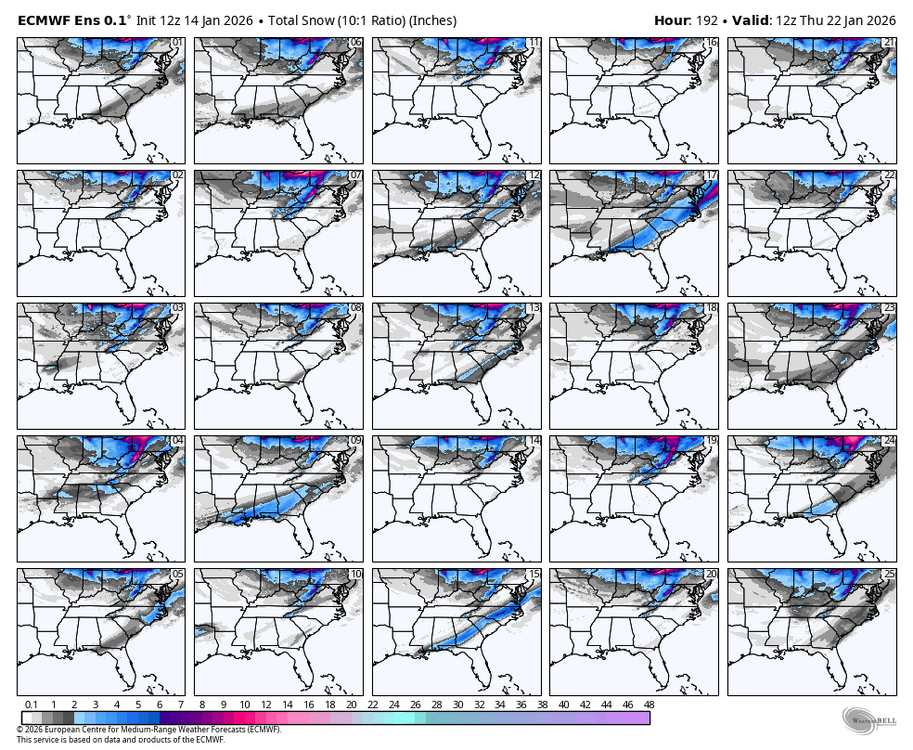
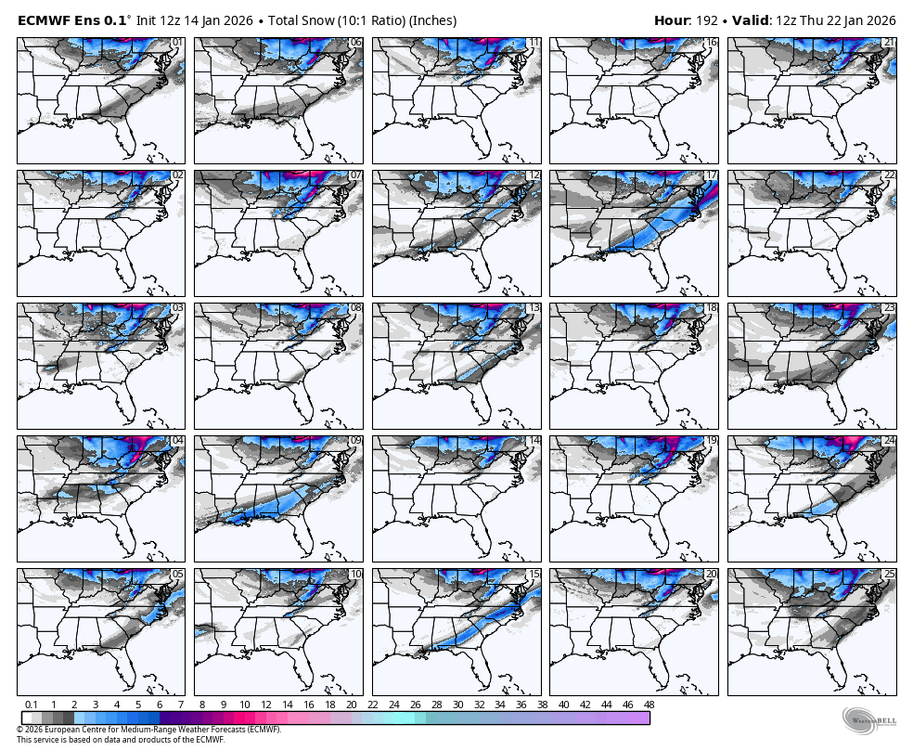
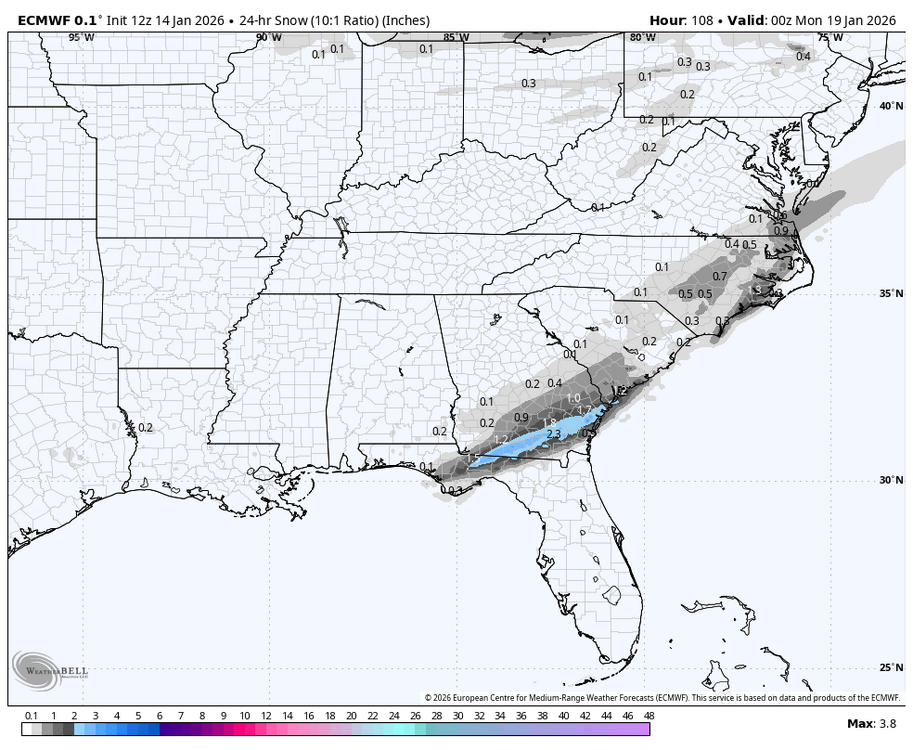
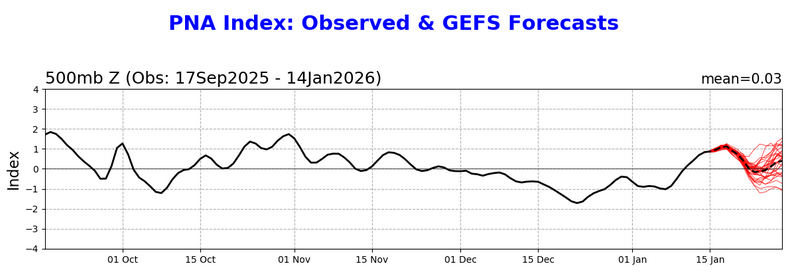
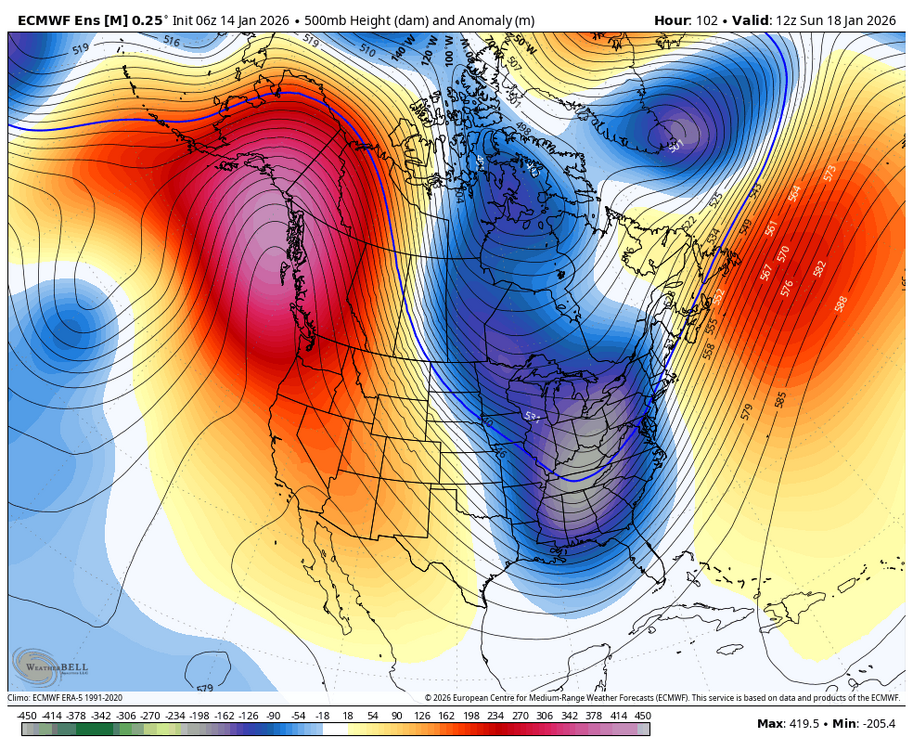
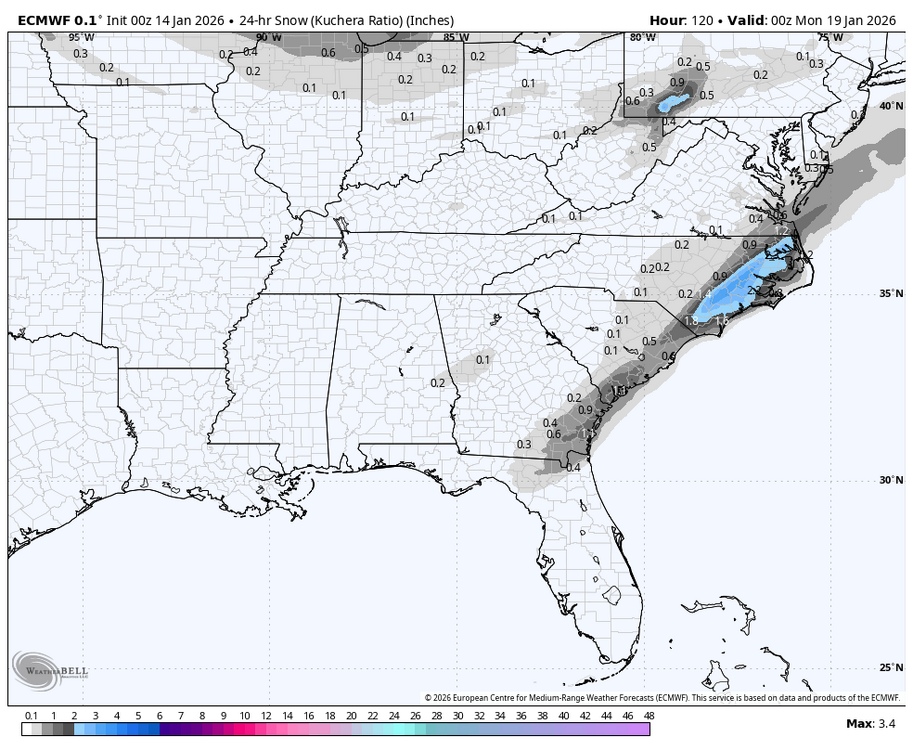
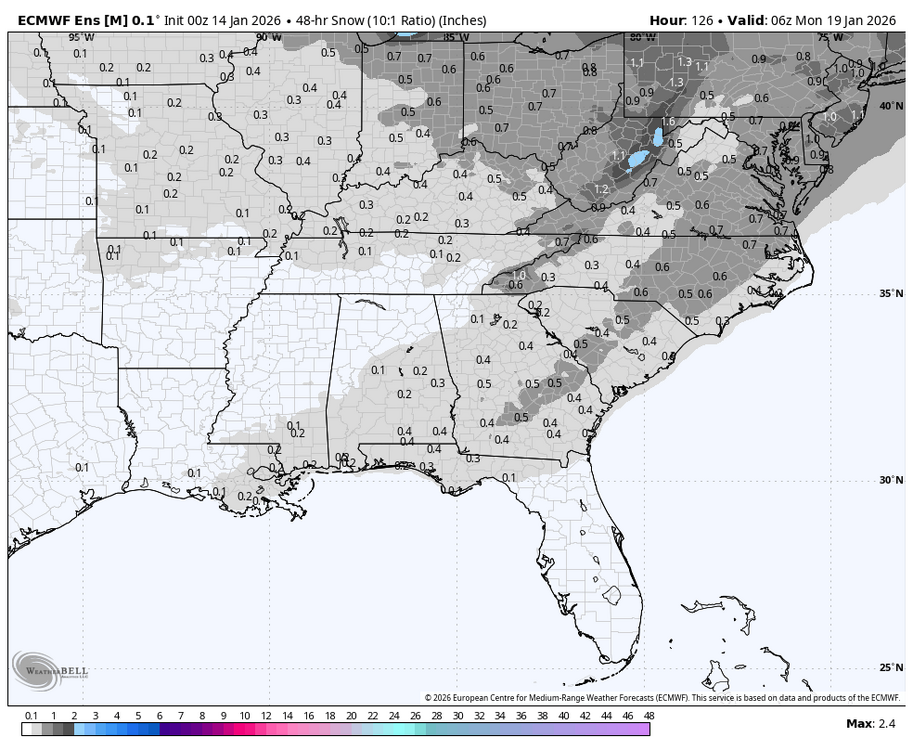
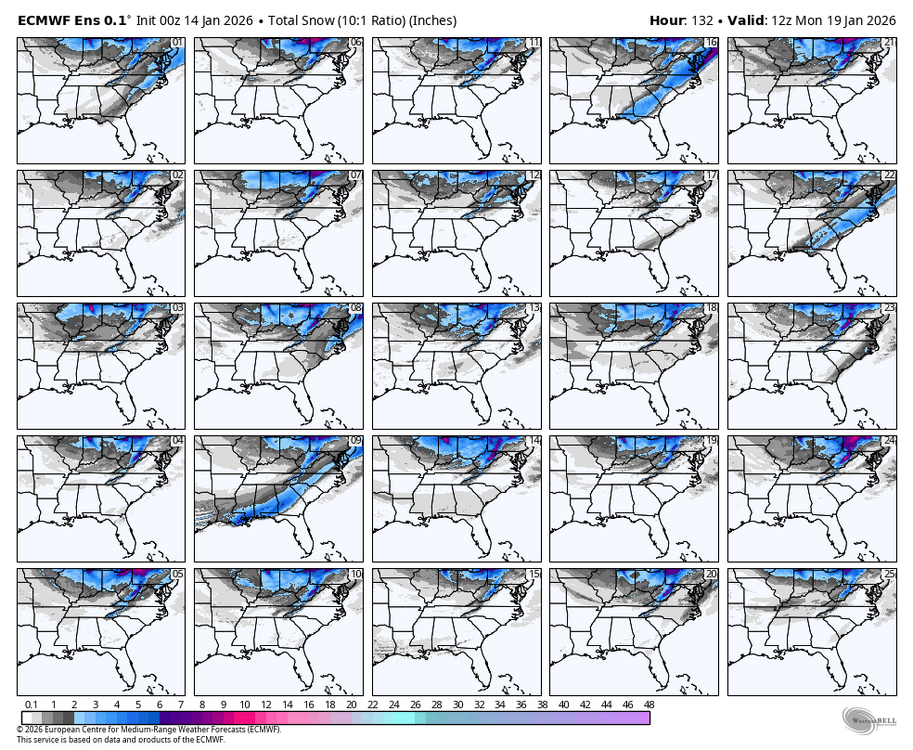
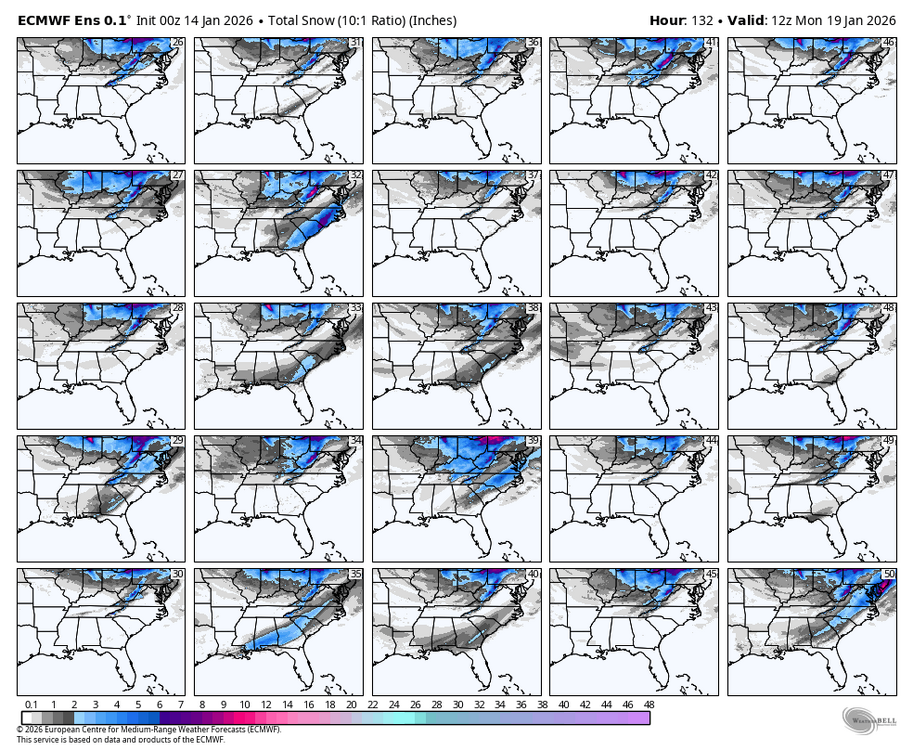
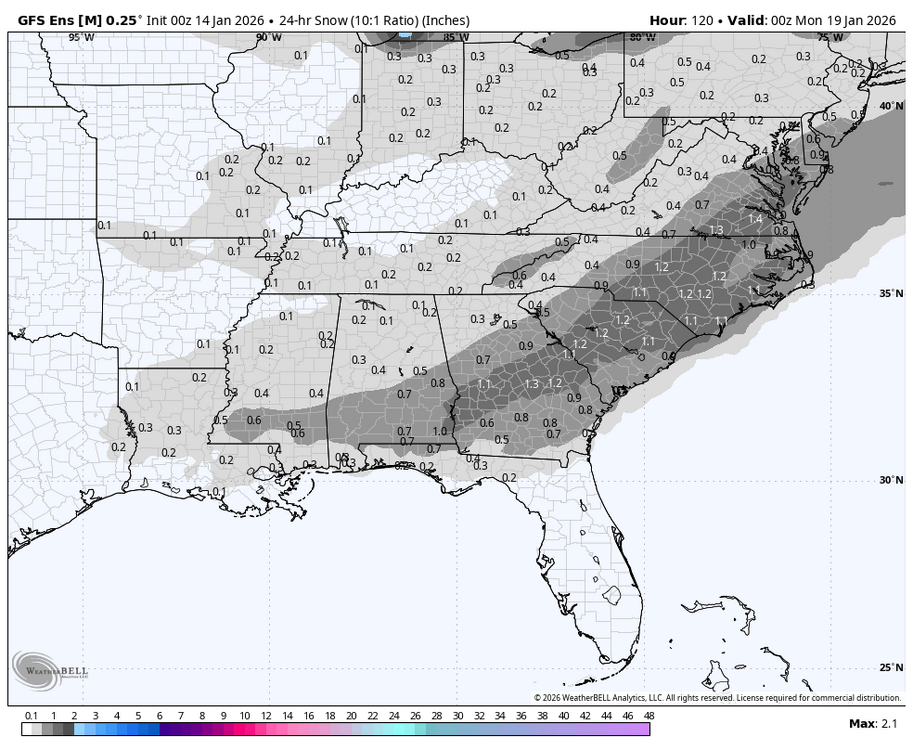
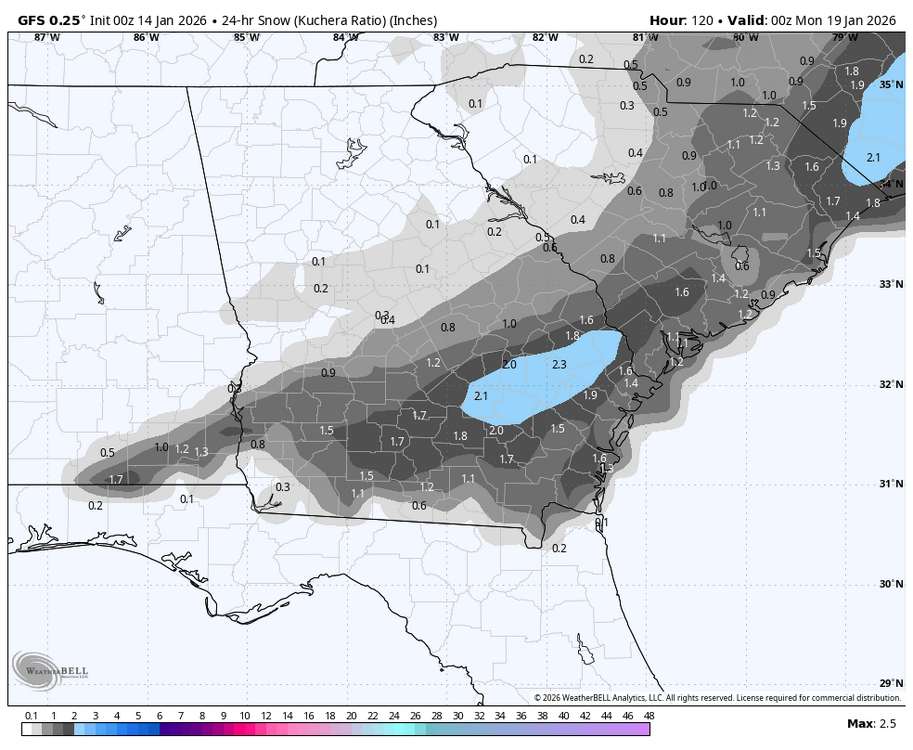

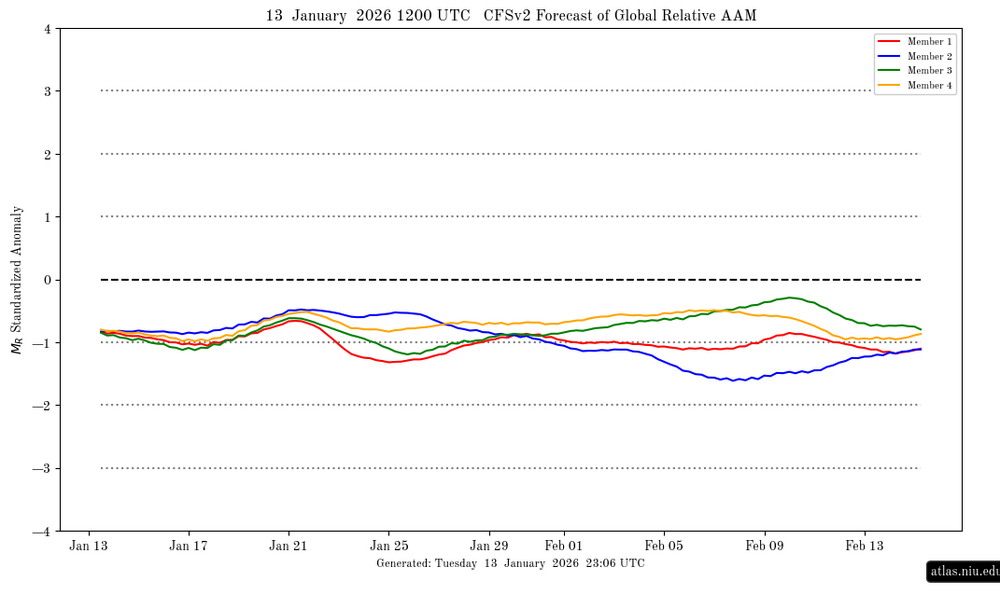
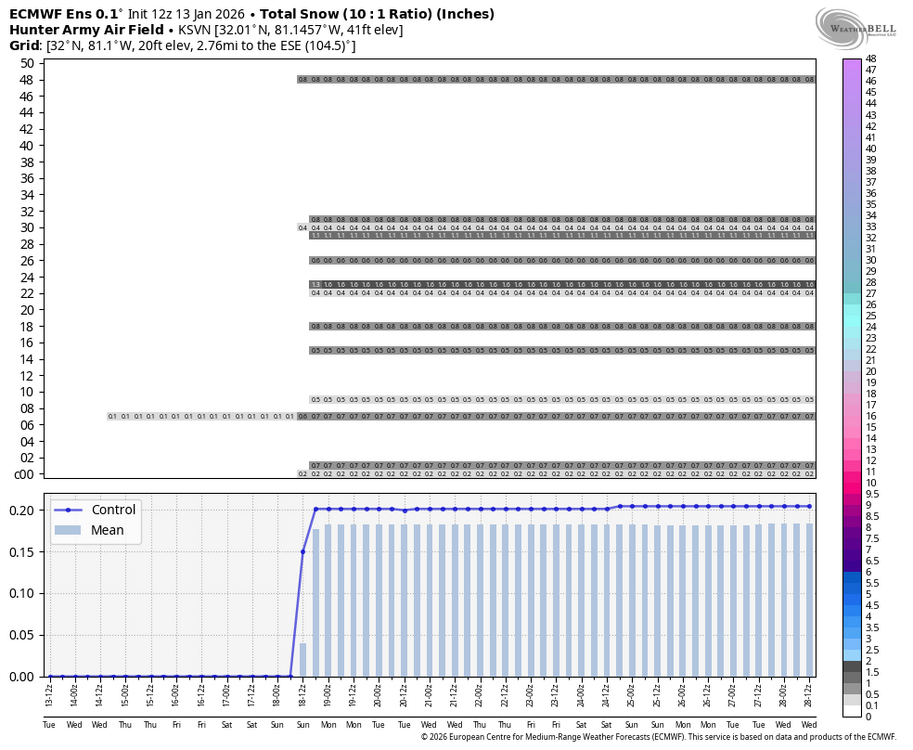
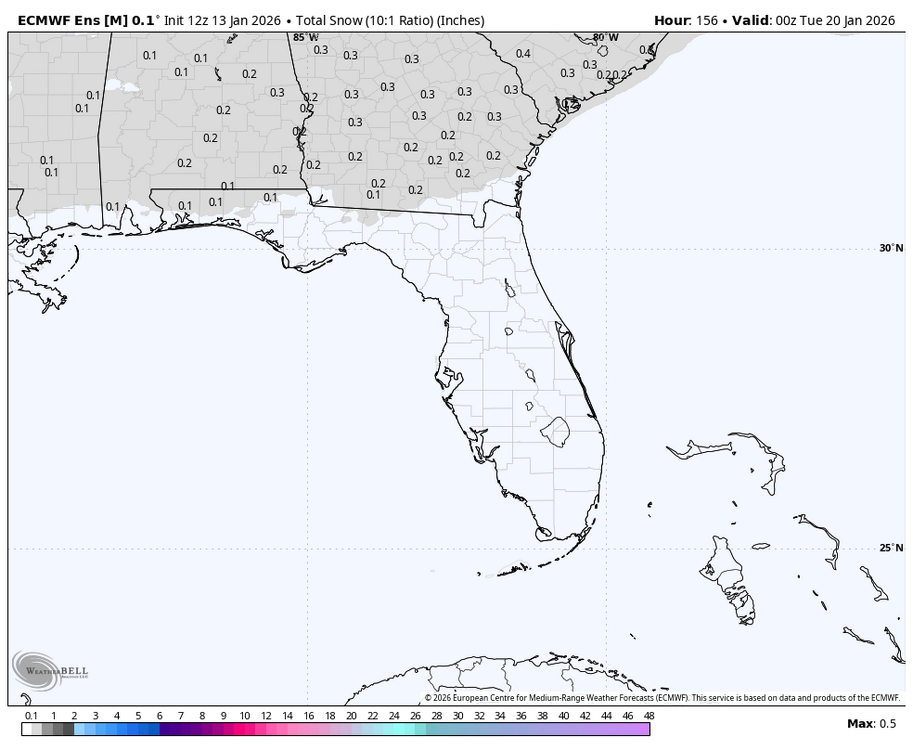
Jan 17-18 Sunday Funday Storm
in Southeastern States
Posted
18Z Euro would be a dream come true for some S GA snow lovers with a max of 1.2” at Douglas (see below). I’m not betting on that much accumulating there but we’ll see.
How often has Douglas received 1.2”+? Not very at all as the ~120 year wx history shows only 5 times meaning a 1.2” snowfall there would be ~1 in 25 year occurrence. However, all five have been since 1973 meaning that would be a ~1 in 10 year occurrence over the last 52 years:
2/10/1973: 3.0”
12/22-23/1989: 3.3”
2/13/2010: 1.5”
1/3/2018: ~3”
1/21-2/2025: 4.5”